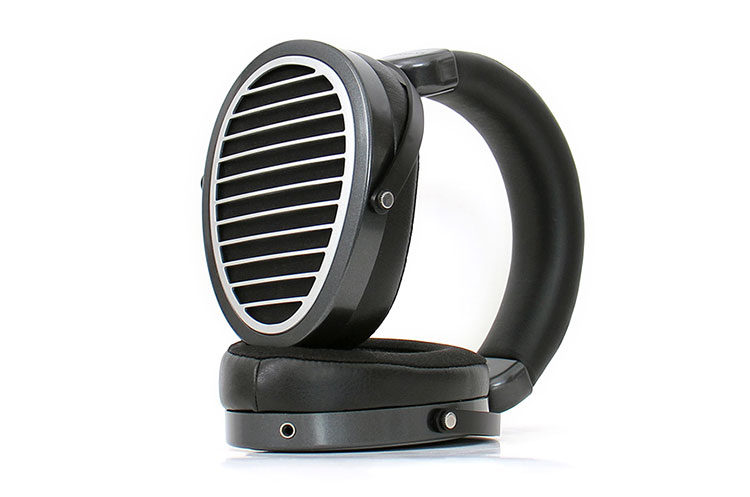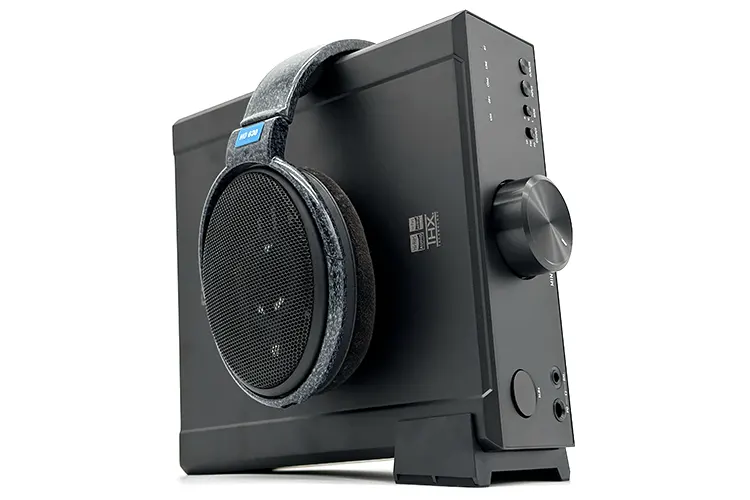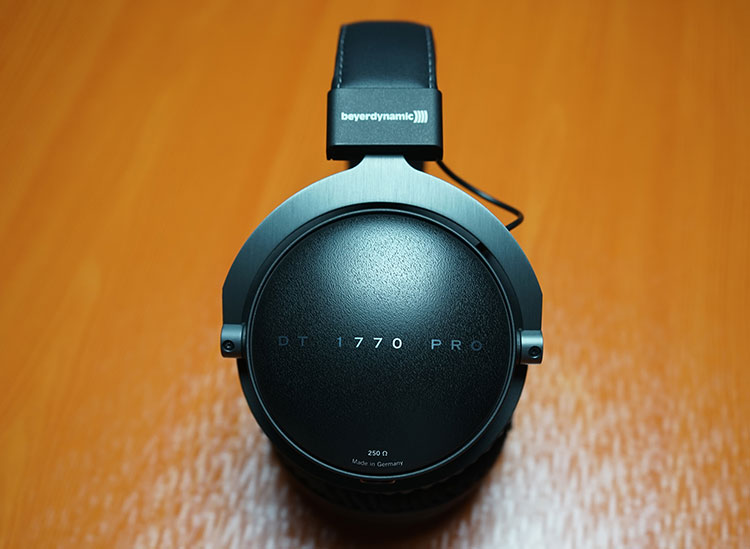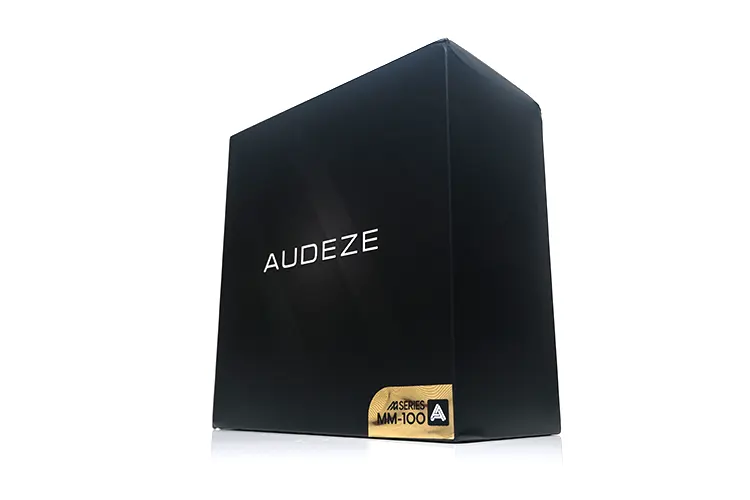Selected Comparisons
The following comparisons to the MM-100 were created using a mix of the Topping DX9 integrated DAC and headphone amplifier, the Cayin N7 DAP, and the Chord Electronic Mojo 2. In all of the comparisons, I used stock cables with a single-ended connection to the selected amplifiers.
HIFIMAN Edition XS
The HIFIMAN Edition XS was launched in early 2022 and has more of an audiophile market bias than gunning for pro-audio enthusiasts. This was our 2022 Bang For Buck Open Headphones winner and its price point is quite close to the MM-100 at $499.
Technical
Both headphones are open-back planar driver designs with the Edition XS rated at a similar 18Ω but less efficient at 92 dB/mW compared to 89 dB for the MM-100. That means you will need a little more current to drive the Edition XS to the same level.
HIFIMAN has not spec’ed the planar dimensions for the Edition XS save for its Neo SuperNano diaphragm. Still, their drivers are usually longer than wider at around 65 x 100 mm compared to the MM-100’s 90mm official size.
Normally the stator and magnet array give the driver assembly its outwardly rectangular appearance. On that basis, the Edition XS version is visibly longer with a suitably sized ovoid cup to accommodate as opposed to the more rounded enclosure of the MM-100.
The big pitch of the Edition XS is the additional dual-sided Stealth Magnet implementation which HIFIMAN has been steadily rolling out to most of its newer headphones.
In some ways, it is the company’s updated answer to Audeze’s Fluxor™ magnet array except HIFIMAN uses a big/small unit array as opposed to each unit being magnetized diagonally in the single-sided MM-100.
Having tested a few of the new Stealth Magnet editions from HIFIMAN there is some tonal changeup compared to the original versions with the technology. Usually, you hear it in the staging depth with some additional power and a smoother set of mids.
Design
The Edition XS is designed for the audiophile, it is not built for studio users. It loses brownie points to the MM-100 for durability and articulation but ticks more boxes for weight and comfort.
For example, the Edition XS weighs 70g less at 405g and you can feel that difference on your head and in the hand when compared to the MM-100.
The reduced weight combined with the relaxed larger ovoid cup fitting and much longer inner pad openings create more space and less pressure around your ears. This results in a more comfortable wearing experience compared to the higher clamping force of the MM-100.
Granted, the MM-100 is not as strong on the lateral pressure as the MM-500 but if the fixed dimensions of the frame are too ill-fitting for your head there is only so much the pressure strap can do. For the Edition XS, you can easily widen or shorten the headband to create the correct length for your head.
The flipside is durability. The MM-100 is more premium-looking for the materials and finishing than the plasticky Edition XS. The MM-100 is probably one of the best builds from a headphone at this price point and not just compared to the Edition XS.
The MM-100 also has improved articulation whereas the Edition XS almost has none, opting for a very rigid frame with just a slight give around the yoke pivot. Placing the Edition XS around your neck when not in use is awkward.
Both use 3.5mm connection systems though the MM-100’s switching system with a single 3.5mm connector is more unique and pro-audio friendly compared to the dual-entry sockets of the Edition XS.
Performance
The Edition XS is not a pair of studio monitor headphones and the MM-100 is not a grandiose-sounding arena-like performer. Their respective staging dimensions are very different.
The MM-100 brings everything right up close to your ear giving you a front-row seat, especially with vocal imaging which is subjectively very forward-sounding. You get a seat much further back with the Edition XS with a staging dimension that is deeper and taller.
As a result, the vocal image from the Edition XS is more relaxed though still quite clear given the additional space the headphones afford the singer. The MM-100 is much more rounded and not as airy but what it does convey very nicely is a stronger sense of rhythm.
The FR of the MM-100 on the lows is flat, flatter than the Edition XS from 200Hz downwards so if you are after elevated sub-bass then the Edition XS offers more presence here.
However, from around 500Hz up to 2K the MM-100 is more elevated which in turn amplifies a lot of instruments that carry some of the MM-100’s mid-bass impact. Hence a better fundamental reproduction and a stronger sense of rhythm.
It is noticeable how much firmer the MM-100 instrument and vocal notes sound right up to that 2k marker. The Edition XS is lighter in note weight, and more ethereal in its delivery. This is more of an ‘observational’ experience than being right in the middle of the music.
The stronger sense of space and clarity in the highs of the Edition XS will certainly appeal more to those who value tonal contrast and grander, more relaxed presentations.
However, if you want more physicality, less chance of vocal sibilance, and everything projecting right in front of you then the MM-100 is the more engaging option.
Sennheiser HD 600
Probably one of the most well-known headphones in the market today used by the Pro-Audio community. It also has quite a rabid following in the audiophile niche going back to its launch in 1997. FYI, this version is the older marble edition and not the 2020 refreshed version.
Technical
We switch over to a dynamic this time with the HD 600’s 42mm driver complemented by an ultra-light aluminum voice coil design tucked into an open-back ovoid cup enclosure.
You will get something vastly different on a technical and tonal level compared to the 90mm planar driver inside the MM-100.
With its 300Ω impedance rating, the HD 600 is also much more responsive to an amplifier with a stronger voltage bias compared to the 18Ω MM-100.
Its SPL is based on Vrms rather than mW at 97 dB @1 kHz / 1 Vrms as opposed to 98 dB/mW @1kHz for the MM-100. That is equivalent to around to a more sensitive 103 dB/Vrms for the Audeze rating or 91.8 dB/mW for the HD 600.
That is not to say you cannot drive the HD 600 from portable sources or lower-powered amplifiers. Rather, it sounds optimal with amplifiers that excel in voltage delivery such as OTL tube amplifiers, or have a higher output impedance rating which was more the case back in the 1990’s.
The MM-100 is more efficient with a higher SPL so its choice of amplifier to sound ‘optimal’ will be wider than the HD 600 though both should not pose too many issues with the quality of today’s desktop amps at most price points.
Design
The HD 600 sample I have here is very much a product of its time, more so with the pre-2020 refresh marble edition.
Despite its renowned durability and lighter weight, the plastic-fantastic classic ovoid cup and single headband frame design are cheaper-looking. Mind you, my model is still as good as new externally but I have looked after it to ensure that it does.
Not only is the MM-100 more modern looking but its magnesium alloy frame, dual-entry single connector cable system, and superior cup articulation make it a more versatile studio offering.
Despite the lack of comparative weight, I would not say comfort is a home win for the HD 600 compared to the MM-100. The Sennheiser has more lateral clamping pressure than the MM-100 but its suede pads are softer and do get flatter over time compensating for the clamp.
The MM-100 is a bit looser, with maybe more vertical than lateral pressure with its deeper leather gel-filled pads also mitigating any potential for clamping pressure discomfort. I can’t see these pads going as flat as the HD 600 pads but they clear the ear a bit more and feel less claustrophobic.
If it were not for the ubiquitous nature of Sennheiser headphones in the market today I would have said its 2-pin connector system is a bit more niche than the 3.5mm single-entry jack of the MM-100.
Both are long enough cables for studio work with pros and cons. I find the MM-100 much lighter and easier to move around and it does have a nicer finish between the two. The rubbery jack of the HD 600 cable might take more of a beating in a work environment though.
Performance
The HD 600 is a very close competitor to the MM-100. In truth, it has some wins over the Audeze tuning but there are some advantages to the MM-100. I think this might come down to preference and use cases.
Neither has a huge soundstage, though the MM-100 offers a more linear and deeper bass response down to 20Hz compared to the noticeable roll-off from the HD 600 around 50Hz.
This is where the MM-100 wins out for me with that firmer bass performance. The HD 600 is nice and punchy but not as well defined and does not carry the same note fundamental as the MM-100’s equivalent through that 100Hz region.
The HD 600 compensates with more mid-bass presence and bloom so the timbre has a slightly softer warmer tone throughout the midrange instruments and vocal timbre.
Combined with a 1-4k range that is relatively more neutral in its imaging the HD600 has a evenly balanced midrange tonal quality compared to the MM-100’s equivalent. A potential win here for the HD 600.
I did say preferences though. The MM-100’s lifted 2-4k amplitude combined with stronger harmonic overtones from its 8-10k peak will create a more immediate level of contrast and immediacy in the vocal performance compared to the HD 600. With the DX9 pairing, I picked up a little bit more air and separation in the MM-100 mids.
The drawback is that a slightly stronger treble overtone in the upper mids means higher-pitching vocal harmonics have a slightly sharper sibilant tone, albeit brief and not that dominant.
The HD 600 cruises through sibilance like it isn’t there with the DX9 pairing as well as offering more of a natural 4-6k fill for percussion notes.
beyerdynamic DT 1770 PRO
A very popular brand in the pro-audio market, the DT 1770 PRO was launched in 2016 with our review coming out later that year (we feel old saying that). It is still one of the top sellers for the company in 2024.
Technical
Though a well-known studio brand and headphone, the beyerdynamic DT 1770 PRO is perhaps even further apart from the MM-100 than the HD 600 with its closed-back dynamic driver design and high impedance rating of 250Ω.
Inside, it uses a 45 mm dynamic 2nd generation Tesla neodymium driver with a three-layer compound membrane and in some ways is beyerdynamic’s answer to the MM-100’s Fluxor magnet technology in trying to ensure as much of the diaphragm as possible beyond the center around the coil is under control.
As with the HD 600, the DT 1170 PRO’s high impedance means it will favor an amplifier with a stronger voltage bias.
OTL or SETA amplifiers will typically deliver that but bear in mind that the PRO is a mixing headphone it’s likely going to be more about output impedance matching from studio rigs such as a Mackie.
You should have less of an issue with the MM-100 and output impedance requirements though with a nominal SPL of 102 dB/mW the DT 1770 PRO is the marginally more sensitive of the two headphones.
Design
If there was one headphone to compete with the MM-100 in terms of durability in this lineup then it is the DT 1770 Pro. It is not all metal like the MM-100, but its mix of aluminum, stainless steel, and stiffened molded plastics makes for one very tough set of headphones.
Some love the classic noir of the DT 1770 PRO, it has a certain timeless appeal with its form factor often popping up in many a video or commercial shoot. However, I will give props to the MM-100 for its more modern and intricate aesthetics.
The DT 1770 PRO is also a clamping beast, making the MM-100 feel almost positively loose on the head. With its leather pad options, some might find the beyer fatiguing on the head for comfort and heat but the alternative “Black Panther” velour pads are much comfier.
I would say the MM-100 is the technically comfier with a better pressure balance over a longer session but if you want a very secure fit and that closed-cup superior level of isolation the DT 1770 PRO is the way to go.
Both of these headphones are single-entry for cables though the dual-entry options of the MM-100 give it a distinct advantage. You get two longer 3m industrial-looking rubbery cables with the DT 1770 PRO; a coiled and straight version with 3.5mm plugs and a 6.35mm converter for both.
One final note, the DT 1770 PRO uses a 3-pin mini-XLR for its stock connection which needs to be converted to a 4-pin (converter cable cheapest method) to allow you to use a 3rd party-balanced mini-XLR cable. It is much easier to roll for the MM-100’s 3.5mm TRS connector.
Performance
I would place the DT 1770 Pro close to a mixing headphone category whereas the MM-100 strikes me as more of a monitoring headphone.
That is not to say the niches are mutually exclusive, either could share some of the duties of the other. Rather, the strengths of the DT 1770 PRO are more on the lows and getting a better grip on thinning the bass out to make room for the all-important kick drum channel when creating mixes sub-100Hz.
Its stronger 20-200Hz elevation means anyone using shelving boosting techniques should enjoy the DT 1770 PRO’s capability as it remains pretty steady from 20Hz right up to 100Hz.
The MM-100 open-back design combined with the linear planar creates a linear, neutral bass alternative. It’s less in-your-face by a country mile, faster, and perhaps more physical in its presentation but lacks that same substantive fundamental.
The DT 1770 Pro does have a noticeable 100-200Hz suck-out, which I suspect helps retain a stronger level of bass-to-mids separation but can rob lower-midrange instruments of some substance, an area in which the MM-100 does better.
If you are after more midrange immediacy then the MM-100 has the advantage. The DT 1770 Pro has some elevation around 1-2k but generally has a darker midrange tone and a slightly muted vocal delivery.
A more substantive 2-4k dip pulls back the DT 1770 Pro’s higher-pitched singers’ presence relative to the intimate staging of the MM-100. Some would argue the buyer is a little emotionless in its vocal delivery.
Neither is lovely harsh sounding through the lower treble, with the DT 1770 Pro a little more prominent from 7-10k but it doesn’t resonate quite as much in vocal harmonics as the MM-100 on account of that 2-4k dip.
My Verdict
The Audeze MM-100 is Audeze’s current entry-level headphone but carries plenty of traits that Audeze, (and Manny) have been tinkering with on their higher-end offerings.
This is a high-energy set of mid-forward open-back planar headphones with an impressively transparent quality that will faithfully mirror the system it is connected to. It can scale where power is available, punch hard when needed, and sound wider with improved separation if you can switch the cable to a balanced alternative.
What it will not do is hugely increase the bass shelf similar to the DT 1770 Pro so its application in the studio will be quite different. You could argue both are complimentary tools for different purposes.
It might also disappoint audiophiles looking for huge soundstages, relaxed mids, or plenty of sub-bass presence. If you are an MM-500 fan then a lot of this might be familiar territory.
Hard to finish without mentioning that at this price point, the quality of the build is an important positive. The magnesium materials and fold-flat articulation not only give a premium look but also make them a very flexible set of headphones for on-the-go.
Audeze MM-100 Technical Specifications
- Transducer-type planar magnetic
- Magnetic structure Fluxor magnet array
- Phase management Fazor
- Magnet type Neodymium n50
- Diaphragm-type Ultra-Thin Uniforce
- Transducer size 90mm
- Max power handling 5w RMS
- Minimum power recommended >100mW
- Recommended power level>250mW
- Max spl >120 dB
- Frequency response 20Hz to 25kHz
- Sensitivity 98 dB/1mW (at drum reference point)
- Impedance 18 ohms
- THD <0.1% @ 100 dB SPL, @1khz
- Weight 475g





